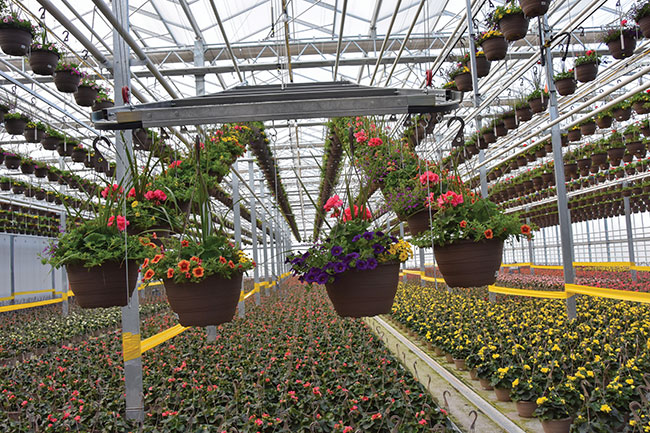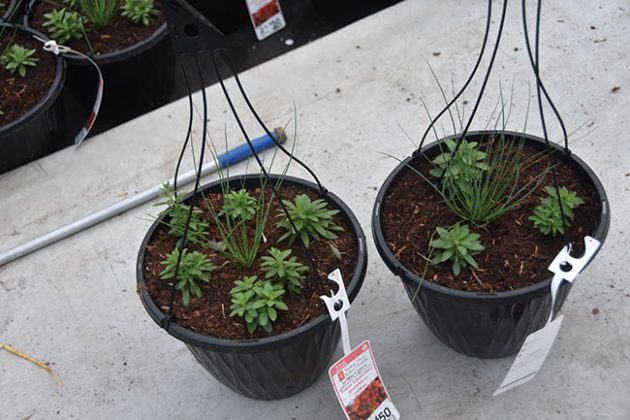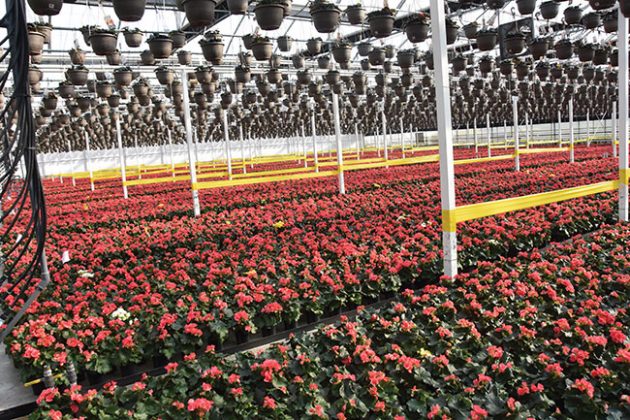
Features
Business
Flowers
Labour
Management
19 Consequences of viciously impeded development
Smart business practices could help an operation weather through uncertain times.
July 14, 2020 By Melhem Sawaya
 The input cost was high for this hanging basket system, but installing it was an excellent decision overall for more efficient product movement and irrigation. All photos: M. Sawaya.
The input cost was high for this hanging basket system, but installing it was an excellent decision overall for more efficient product movement and irrigation. All photos: M. Sawaya. Every year, the month of July is the best time for most greenhouses to reflect on the year passed and adjust for the coming year. That is especially true for this year.
As I write this article on May 25, 2020, things are looking much better for the greenhouse ornamental industry compared to just three weeks ago. Whether independent or box store, both types of garden centers are open to the public with social distancing enforced. Even with controlled numbers of customers and access to merchandise, product is disappearing faster than any other time that I have seen in my 42 years in the greenhouse business.
The question now is, if a disease makes the consumer appreciate the beauty, benefits and psychological power of plants and gardening, why then can we not keep up the momentum, even without a pandemic?
Obviously, COVID-19 has caused irreparable damage and losses to many growers. Others were not as severely hurt, and a few ended up doing better than in previous years. The difference was partly in the crop grown.
If you were growing Easter lily, you did not have a chance of making good on it. A solid percentage of Easter lily crop usually goes to fundraisers and churches; both were cancelled with the implementation of social distancing.
Pot mums were a little better, but with stores especially in the States giving most of their attention to food supplies and toilet paper, plants in general were not a priority for them. Because pot mum numbers are usually high for Easter, even a 30 per cent loss translated to a large dollar amount for many growers.
For the few growers who grew hydrangea, they were lucky and somehow were able to sell most of their crop.
Early spring crops were sold if the grower initiated alternative channels such as curbside pick up or promotions via social media.
Then garden centers opened, and many new ways of marketing plants were already in progress. This exposed plants to both old and new customers, and the spring crop moved steadily even when the weather was not cooperative.
Here are 19 consequences of viciously impeded development (acronym: COVID), whether during a pandemic or not, as well as what practices can cushion the negative impact and improve profits in normal years.
- For growers who were running behind in their planting schedules, when COVID-19 hit, many of their employees decided to stay home either for fear of the disease, the government incentive to stay home and get paid, or both. Many of the growers had to reach out to family members for help. Getting things done on time is a must, not a choice.
- Employee evaluations should reflect their actions this year or in any year. Reward the ones who stood by your side and are doing a great job and they will stay. Labour turnover is one of the top reasons for profit shrinkage in any industry.
- Give higher positions and higher pay to the responsible and deserving, particularly, if you want to keep these employees, or else they will be looking somewhere else for a job. Saving money by not acknowledging what your employees deserve is the beginning of the end for your business.
- Advertise for new positions when needed within the company first before reaching out to outsiders. You know your employees and the employees know what to expect. These are the two main ingredients for successfully filling a work position.
- Employees who do not show interest in their job or try to advance their knowledge do not deserve any significant raises other than for cost of living. But most importantly, let them know what your decision is based on.
- With fears of the sales season going later than normal this year, growers in general grew their crops on the cooler side. This translated to the best crops I have ever seen, with the largest and most number of flowers; a practical and effective procedure came out of COVID-19.
- Certain production techniques that were applied this year due to COVID-19 proved to be highly effective, like the use of ethrel for delaying flowering. Though we used to calculate 9 weeks from the last treatment to flowering, this year we pushed the envelope to 6 weeks, and it saved many crops from diseases by minimizing old flowers. Note that too many applications of ethrel will lead to more compact plants, so be cautious of using this with
other PGRs. - Greenhouses that could keep up with the work using the limited labour available were the operations that had a high level of effective mechanization. Mechanization is only effective when you simplify product offerings (e.g. varieties, pot sizes).
- Many growers do not overproduce in their available growing area, and it paid off this year more so than other years. No extra work was needed to respace or extra time spent maintaining crowded plants, leading to efficient product preparation for shipping. The quality was superb. I worked with many growers who thought packing the greenhouse would translate into more profit. We cut production volume by 20 per cent, and the profit margin went up by 20 per cent. This was due to fewer unnecessary labour costs, better quality of plants, and a higher average price per unit because there was no price reduction for later products.
- Simplify the product mix. Consumers are getting confused with so many. Grow cultivars of the same genus. Pick the best cultivar that will make the consumer successful and produce it in the best way possible. This year, where the consumer’s fast turnaround in stores is the most limiting factor for sales volume per day, simplicity is king.
- Do not wait for your customer to tell you what cultivar and amount to grow. Approach them with a plan based on facts of the best cultivars, pot sizes, amounts, and times to sell. If you do not reach out to your customer with information, then the programs will be forced on you, which is a lose-lose situation most of the time.
- Many growers work on the programs together with their customers, which is the best strategy. They visit trials, discuss what they see and come up with a program that is workable for everyone. I have seen programs suggested to buyers by breeders, which then the growers must produce – some turn out to be the biggest disasters. Most of these programs are supposed to be exclusive to one customer.
- Never rush to new varieties; try them out and compare them to the older ones. When you know how to grow the new varieties and you see that they are indeed better, then drop the old variety. In my experience, the number one factor for shrinkage in the greenhouse is adopting new varieties before trialing them on a small scale.
- COVID-19 forced growers to go after different outlets for their products, like curbside pickup, selling online, using social media to advertise their product, and setting up shop in front of their greenhouses. These means will not take the place of large outlets, but they moved a good volume of plants and are alternatives that are here to stay.
- Buyers who took advantage of the scary COVID-19 situation and dropped the price before shipping will have a more difficult time finding enough suppliers next season. Growers must make a certain margin to survive, and when their cost has gone through the roof and the buyer drops the price for no reason, then there is no choice but to move the product elsewhere.
- COVID-19 could be the reason for better spring product sales, which will make some growers want to expand their facilities right away. Be cautious here because product demand is only one factor to consider. Sometimes expansion creates many other expenses that are not proportional to the dollars generated from extra sales, like more trucks, carts, utility services and most importantly, qualified staff. Expansion is great when all of these factors are taken into consideration.
- July is a great month for evaluating your business and deciding on future directions. Crops, expansion, working less, delegating more responsibilities to others, mechanization, costing your product – COVID-19 has made us think about these issues more seriously.
- Every person needs a certain level of stress just to survive. Without it, we are dead. Manageable stress gives us a great sense of satisfaction and accomplishment that drives us to achieve more and take on a higher level of stress. The key word here is ‘manageable’, and if that is not possible, then we must try to reduce the causes of our stress. COVID-19 pushed stress to much higher levels
- Last but not least, the people who go through situations like COVID-19 and see the positives in all this share the attitude of Helen Keller. Many of her inspirational quotes are from actual situations that she lived and thrived through. Here are two of my favourites:
“A bend in the road is not the end of the road…unless you fail to make the turn.”
“Character cannot be developed in ease and quiet. Only through experiences of trial and suffering can the soul be strengthened, ambition inspired, and success achieved.” ~ Helen Keller
Melhem Sawaya of Focus Greenhouse Management is a consultant and research coordinator to the horticultural industry, mel@focusgreenhousemanagement.com.
Print this page

